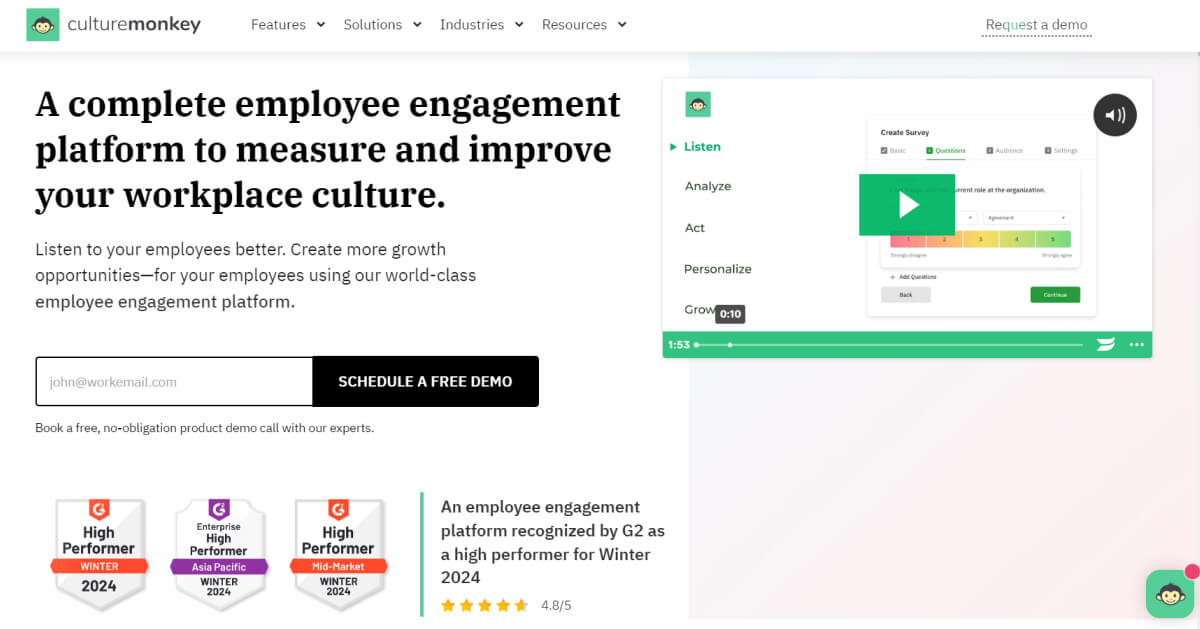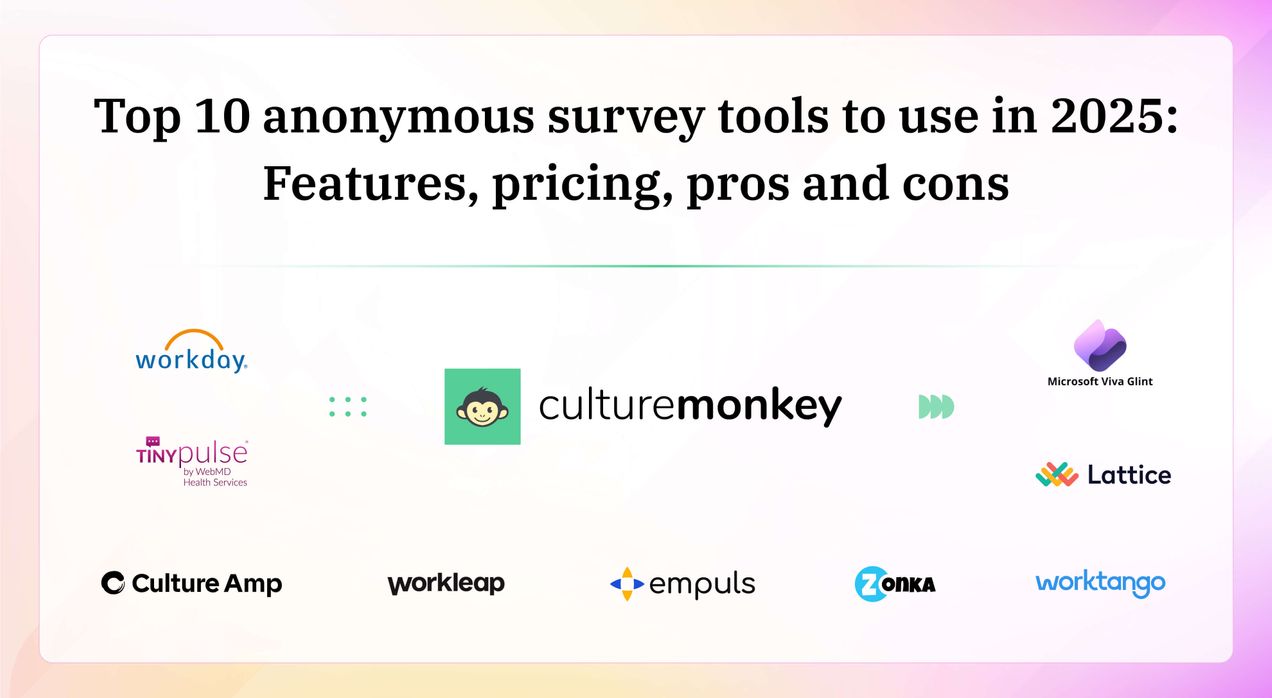Why and how to use an anonymous comment box for honest employee feedback

Employees often hesitate to share honest feedback when their identity is attached to it, fearing potential backlash or strained relationships. This hesitation can lead to unresolved issues, declining morale, and reduced productivity.
Take, for example, a software development team member who consistently notices inefficiencies in the project management process but refrains from speaking up because the project lead is a close friend. Without a way to provide anonymous feedback, such issues might never be addressed, hindering team performance.
This blog explores the importance of using an anonymous comment box for collecting feedback, its benefits, and the best practices to make it work. You'll also learn about tools and templates, and how these solutions can lead to meaningful improvements in employee engagement and performance.
What is the anonymous feedback method?

The anonymous feedback method allows employees to share their thoughts, concerns, or suggestions without revealing their identity. By ensuring confidentiality, this approach encourages more candid responses, as employees feel safe from potential backlash. It is an effective way for companies to gather unfiltered feedback on a wide range of topics, from management practices to workplace culture.
This method can take various forms, including an anonymous comment, online suggestion box, digital platforms, or surveys. An employee suggestion box, for example, serves as a physical or digital space for anonymous feedback. These tools can help management identify issues that might otherwise go unnoticed due to fear of retaliation. By using feedback box ideas such as a suggestion box template or a digital suggestion box, organizations can streamline this process.
When implemented effectively, the anonymous feedback method fosters transparency, boosts employee trust, and provides a clear channel for continuous improvement. As we explore throughout this blog, there are numerous types of tools and techniques, such as a company suggestion box or safety suggestion box, that can make the anonymous feedback process seamless and effective.
What are the benefits of anonymous feedback?

Anonymous feedback provides a valuable opportunity for employees to share their honest opinions without fear of judgment or retaliation. This type of feedback system encourages openness and helps organizations identify issues that might not surface otherwise. By implementing an anonymous comment box or similar tools, companies can create a safe space for genuine employee insights to share suggestions.
- Honest communication: Employees are more likely to provide truthful feedback when their identity is protected. This leads to more accurate insights, enabling management to understand real issues without sugar-coating or omissions.
- Increased participation: Anonymity encourages broader participation, especially from employees who might otherwise fear backlash or feel uncomfortable speaking up. This results in a more comprehensive understanding of workplace dynamics.
- Improved trust: Offering tools like an employee suggestion box signals that the company values transparency. It shows employees that their opinions matter, building a culture of trust and openness over time.
- Uncover hidden issues: Anonymous feedback helps uncover deeper issues, such as team conflicts or concerns about leadership. These are often hard to address openly, but anonymity provides a safe outlet to bring them to light. In fact, Zensai reports that 74% of employees would provide more feedback if it was anonymous.
- Better employee engagement: A suggestion box for employees keeps communication channels open. When employees feel heard through continuous feedback, they tend to be more engaged and committed to the organization’s success. It is also seen to reduce turnover by up to 59% reports Gallup.
- Informed decision-making: Gaining candid feedback allows companies to make decisions based on genuine employee concerns and experiences. This leads to more strategic improvements in policies and workplace environments.
- Boosted workplace morale: Knowing that their opinions are valued and acted upon enhances employee morale. Anonymity gives them a sense of empowerment, which contributes to a more positive and collaborative workplace culture.
What is an anonymous suggestion box?

An anonymous suggestion box is a tool that allows employees to provide feedback, ideas, or concerns without revealing their identity. It offers a secure platform for employees to express themselves freely, helping organizations gain genuine insights. By encouraging honest communication, an anonymous suggestion box plays a critical role in fostering a transparent and open work culture.
Typically, a suggestion box can be either physical or digital. A physical employee suggestion box might be placed in common areas, while a digital suggestion box offers a more convenient, technology-driven alternative. Both serve the same purpose: to provide a space for anonymous feedback that management can review and act upon.
Employing a company suggestion box encourages employees to voice their thoughts on various issues, from operational improvements to safety concerns. Many organizations also use a safety suggestion box specifically to capture feedback related to workplace safety.
Tools like free suggestion box ideas can simplify the setup process, making it easier for companies to implement these systems.
Whether using a traditional or digital method, an anonymous suggestion box helps organizations understand their employees' true concerns while creating a culture of trust and continuous improvement. It’s a straightforward yet effective way to keep the lines of communication open.
Do anonymous suggestion boxes work?

Anonymous suggestion boxes can be highly effective when implemented correctly. They provide employees with a safe and confidential way to voice concerns, share ideas, or offer feedback. This anonymity boosts honest communication by 58%, allowing companies to address issues they might not otherwise hear about. When used as part of a broader feedback strategy, suggestion boxes can significantly improve workplace dynamics.
However, the success of an anonymous suggestion box depends on several factors. Management must genuinely commit to reviewing and acting on the feedback received.
Employees need to see that their suggestions lead to tangible changes; otherwise, the anonymous suggestion box feature will lose credibility. Second, maintaining strict anonymity is critical. If employees fear their identities might be revealed, participation will decline.
A digital suggestion box, for example, can enhance confidentiality and ease of use, making it more likely for employees to contribute. Additionally, employing feedback box ideas, such as a clear suggestion box template, ensures the process is straightforward and accessible.
Overall, anonymous company suggestion boxes work when combined with genuine engagement from leadership. Whether it's a company suggestion box or a safety suggestion box, they can uncover valuable insights, improve employee satisfaction, and foster a culture of trust when feedback is taken seriously.
Why is having a company suggestion box important?

A company suggestion box is a crucial tool for maintaining open lines of communication between employees and management. So, it's important to have a structured platform where employees can submit ideas, raise concerns, or offer feedback in an anonymous or transparent manner.
1. Encourages innovation
A suggestion box creates a dedicated space for employees to share creative ideas for new processes, products, or improvements. These suggestions can lead to valuable innovations that drive the company forward and give it a competitive edge.
2. Identifies cost-saving opportunities
Employees often spot inefficiencies or resource wastage that May not be obvious to management. A company suggestion box helps capture these insights, leading to actionable steps that can reduce operational costs and boost profitability.
3. Enhances workplace safety
A safety suggestion box allows employees to anonymously report unsafe practices or potential hazards. Addressing these concerns quickly ensures a safer workplace and demonstrates a commitment to employee well-being.
4. Increases employee ownership
When employees are encouraged to submit ideas and feedback, they feel more connected to the company’s success. This ownership leads to higher engagement and fosters a positive company culture where contributions are valued.
5. Fosters continuous improvement
A company suggestion box provides a steady flow of great ideas that fuel continuous improvement. This ensures that the organization remains adaptable, regularly refining its processes based on employee insights.
6. Gathers diverse perspectives
By offering a suggestion box for employees, companies can collect feedback from different departments, customers, and roles. This diversity of perspectives leads to well-rounded solutions that address various aspects of the organization.
7. Prevents small issues from escalating
A suggestion box gives employees a way to raise concerns before they become bigger problems. By addressing these early warnings, companies can resolve issues proactively and prevent them from affecting morale or performance.
Types of anonymous comment boxes

Anonymous comment boxes come in various forms, each designed to suit different organizational needs and preferences.
These tools provide a platform for employees to share feedback, suggestions, or concerns while ensuring their identities remain confidential. Understanding the different types of anonymous comment boxes can help organizations choose the best option to foster open communication and improve workplace culture.
- Physical suggestion boxes: Traditional physical boxes placed in common areas allow employees to submit handwritten comments or suggestions. These boxes are straightforward and can be easily monitored for collected feedback.
- Digital suggestion boxes: Online platforms provide a convenient way for employees to submit feedback electronically. Digital suggestion boxes can include various features, such as categories for feedback and the ability to attach files, enhancing the overall process.
- Anonymous feedback forms: These are structured online or paper forms that employees can fill out to provide specific feedback on various topics. They can be tailored to address particular issues or gather general insights.
- Mobile apps: Some organizations utilize mobile applications that allow employees to submit feedback or suggestions anonymously through their smartphones. These apps often include notifications and reminders to encourage participation.
- Employee engagement platforms: Comprehensive tools designed for broader employee engagement can incorporate anonymous comment boxes as Part of their features. These platforms often provide additional functionalities, such as surveys and polls.
- QR code feedback: By using QR codes displayed in strategic locations, organizations can allow employees to access an anonymous feedback portal quickly. They can use the best QR code generator available in the market to create such QR codes for the feedback collection. Scanning the code directs them to an online submission form, simplifying the process.
- Safety suggestion boxes: Specifically focused on safety concerns, these boxes encourage employees to report hazards or unsafe practices. They can be either physical or digital, ensuring that workplace safety remains a top priority.
How to set up an anonymous comment box: Step-by-step guide

Setting up an anonymous comment box is a straightforward process that can significantly enhance communication within your organization.
By providing a platform for employees to share their thoughts without fear of identification, you foster a culture of openness and trust. Here’s a step-by-step guide to help you implement an effective anonymous comment box system.
- Define your objectives: Start by determining the purpose of the anonymous comment box. Consider what types of feedback you want to collect—whether it’s general suggestions, safety concerns, or ideas for improvement.
- Choose the type of comment box: Decide between a physical or digital anonymous comment box. Physical boxes can be placed in common areas, while digital options can include forms on your intranet or dedicated apps.
- Select a location: For a physical box, choose a location that is easily accessible yet discreet, such as break rooms or near entrances. For digital boxes, ensure the platform is user-friendly and can be easily accessed by all employees.
- Promote awareness: Inform employees about the new comment box through internal communications. Explain its purpose, how to use it, and emphasize the importance of honest feedback in improving the workplace.
- Develop guidelines: Create clear guidelines for submitting comments to ensure constructive feedback. Encourage employees to provide specific examples and avoid personal attacks to maintain a respectful environment.
- Monitor and review feedback: Designate a team or individual to regularly check the anonymous comment box and review the feedback. Ensure that feedback is acknowledged and addressed in a timely manner.
- Communicate outcomes: Share updates with employees about the feedback received and any actions taken as a result. Transparency shows that management values their input and encourages ongoing participation.
Top anonymous comment box tools & software
Utilizing anonymous comment box tools and software can significantly enhance communication and feedback processes within an organization. These platforms provide a secure and user-friendly way for employees to share their thoughts and suggestions without revealing their identities. Here are the top anonymous comment box tools and software that can help foster a culture of open communication:
1. CultureMonkey

CultureMonkey is a comprehensive employee engagement platform that includes anonymous feedback tools. It allows employees to submit suggestions, participate in surveys, and provide insights into workplace culture, all while maintaining confidentiality.
Additional Key Features of CultureMonkey:
- Customizable Survey Templates: Offers 50+ research-backed templates to tailor surveys to your organization's specific needs.
- Multilingual Capabilities: Facilitates participation from a diverse workforce by allowing surveys to be conducted in multiple languages.
- Continuous Feedback Mechanism: Employs pulse surveys to gather ongoing insights and monitor employee sentiment in real time.
- Engagement Metrics Dashboard: Provides in-depth analytics on 15+ engagement drivers, giving leaders a complete picture of organizational health.
- Integration with HRMS Tools: Seamlessly integrates with popular HR management systems like Zoho People and Workday for streamlined data management.
2. Officevibe
Officevibe is an employee engagement software that features an anonymous feedback tool. It helps organizations gather insights through pulse surveys, enabling management to identify trends and areas for improvement while ensuring employee anonymity.
3. SurveyMonkey
While primarily known for its survey capabilities, SurveyMonkey also offers anonymous feedback options. Organizations can create custom surveys that allow employees to provide input without revealing their identities, making it a versatile choice for feedback collection.
4. Trello
Trello, typically used for project management, can be adapted for anonymous feedback by creating boards where employees can submit comments or suggestions. By using third-party integrations or plugins, teams can ensure that submissions remain anonymous.
Is the suggestion box enough to measure and improve employee engagement?

A suggestion box can be a valuable tool for measuring and improving employee engagement, but it is not sufficient on its own. While it provides a platform for employees to voice their ideas and concerns, relying solely on a suggestion box may overlook other critical aspects of engagement. To create a truly engaged workforce, organizations must adopt a more holistic approach.
While a suggestion box allows for anonymous employee feedback, it should be part of a broader strategy that includes regular check-ins, employee surveys, and performance reviews. Combining these methods ensures a comprehensive understanding of employee sentiments and needs.
Additionally, simply collecting employee suggestions isn’t enough; organizations must actively review and respond to the feedback. Implementing changes based on employee input demonstrates that management values their contributions and fosters a sense of ownership among staff.
Moreover, incorporating other engagement initiatives—such as team-building activities, training programs, and recognition efforts—can further enhance employee satisfaction and morale. In summary, while a suggestion box is a useful component in the employee engagement toolkit, it should be integrated with other strategies for a more effective approach to fostering a committed and motivated workforce.
Why are anonymous feedback tools better than suggestion box?

Anonymous feedback tools offer a modern and efficient approach to gathering employee insights, surpassing traditional suggestion boxes in several key areas. While suggestion boxes provide a basic platform for feedback, anonymous tools utilize technology to enhance user experience and engagement and analyze data. Here are five reasons why anonymous feedback tools are often more effective than suggestion boxes.
- Enhanced accessibility: Anonymous feedback tools are typically digital, making them accessible from anywhere at any time. Employees can easily submit their thoughts using their smartphones or computers, increasing participation compared to physical suggestion boxes, which May be overlooked.
- Real-time feedback collection: Unlike suggestion boxes, which require physical collection and manual processing, anonymous feedback tools enable real-time submission and analysis. This allows management to respond to issues promptly and adapt strategies based on the latest employee insights.
- Advanced analytics: Many anonymous feedback tools come equipped with data analytics features that help organizations identify trends, measure sentiment, and assess engagement levels. These insights enable more informed decision-making, something traditional suggestion boxes cannot provide.
- Greater anonymity assurance: Digital anonymous feedback tools often have advanced security features that enhance confidentiality, giving employees more confidence in sharing sensitive opinions. This level of anonymity can lead to more honest and constructive feedback compared to suggestion boxes, which May not guarantee the same level of protection.
- Incorporation of various feedback channels: Anonymous feedback tools can integrate multiple feedback methods, such as surveys, polls, and open comment sections. This flexibility allows organizations to gather diverse input, providing a richer understanding of employee experiences compared to the singular approach of suggestion boxes.
Role of anonymous survey tools in collecting honest feedback that matter

Anonymous survey tools play with just a few clicks a critical role in collecting honest feedback from employees, ensuring that their voices are heard without fear of repercussions. These tools facilitate a safe environment for sharing insights, leading to valuable data that organizations can use for improvement. Here are five key roles that anonymous survey tools play in gathering meaningful feedback.
- Encouraging openness: Employees are more likely to share their true feelings in an anonymous setting, leading to candid responses that provide genuine insights into workplace dynamics.
- Simplified feedback process: These tools streamline the feedback process, allowing employees to quickly and easily submit their thoughts. This ease of use boosts participation rates compared to traditional methods.
- Targeted questions: Anonymous surveys can include tailored questions that address specific areas of concern, enabling organizations to gather focused feedback on particular issues.
- Benchmarking performance: By regularly using anonymous survey tools, companies can track employee sentiment over time, allowing them to benchmark progress and measure the impact of changes.
- Identifying areas for improvement: The data collected from anonymous surveys highlights trends and common concerns, empowering organizations to make informed decisions on areas needing enhancement.
Conclusion
Implementing an anonymous comment box is a vital step toward fostering a culture of open communication and trust within organizations. By offering a safe space for employees to voice their opinions, companies can gather valuable insights that lead to meaningful improvements in workplace culture, safety, and overall engagement.
While traditional suggestion boxes serve a purpose, leveraging modern anonymous feedback tools, such as CultureMonkey, can enhance the process by providing real-time analytics, encouraging greater participation, and ensuring confidentiality.
Prioritizing anonymous feedback will lead to higher employee satisfaction and retention, making it essential for any organization aiming to thrive in today’s competitive business landscape. Embrace the power of anonymity through popular employee engagement survey vendors like CultureMonkey to transform your workplace and drive lasting change.
FAQs
1. How do you ensure anonymity in an anonymous comment box?
To ensure anonymity in an anonymous comment box, it's essential to use secure platforms such as CultureMonkey that don't store identifiable information. For physical boxes, limit access to the feedback boxes only to designated personnel. Clearly communicate the anonymity policy to employees, reinforcing that their identities will remain confidential and that honest feedback is encouraged.
2. Is an anonymous comment box truly anonymous?
An anonymous comment box can be truly anonymous if properly implemented with security features. Digital tools designed for this purpose typically use encryption and do not collect identifiable data. However, physical boxes can pose risks if not monitored carefully. Transparency about the anonymity measures in place helps build trust and encourages employees to participate freely.
3. Can you track who submits feedback in an anonymous comment box?
No, a well-designed anonymous comment box or website does not track who submits feedback. The purpose of these tools is to provide confidentiality, ensuring employees feel safe sharing their thoughts and are always honest. Digital platforms often utilize advanced encryption and data anonymization techniques, preventing any sort of traceability of feedback back to individual employees.
4. What is the best software for anonymous feedback collection?
The best software for anonymous feedback collection is CultureMonkey. This comprehensive platform allows organizations to gather insights through anonymous surveys and feedback tools. CultureMonkey enhances employee engagement by ensuring confidentiality, providing real-time analytics, and offering users various feedback channels, making it a top choice for organizations seeking honest employee input to implement in their organization.
5. Why are anonymous comment boxes important in the workplace?
Anonymous comment boxes are important in the workplace because they create a safe space for employees to share feedback without fear of retribution. They promote open communication and highlight issues that may otherwise go unreported. It also encourages employees to contribute ideas for improvement, ultimately leading to boosted morale, engagement, and a satisfied workforce.



